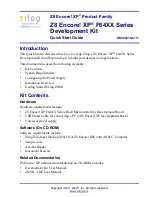
995
11100B–ATARM–31-Jul-12
SAM4S Series [Preliminary]
38.6.3.1
Not Powered State
Self powered devices can detect 5V VBUS using a PIO as described in the typical connection
section. When the device is not connected to a host, device power consumption can be reduced
by disabling MCK for the UDP, disabling UDPCK and disabling the transceiver. DDP and DDM
lines are pulled down by 330 K
Ω
resistors.
38.6.3.2
Entering Attached State
To enable integrated pullup, the PUON bit in the UDP_TXVC register must be set.
Warning: To write to the UDP_TXVC register, MCK clock must be enabled on the UDP. This is
done in the Power Management Controller.
After pullup connection, the device enters the powered state. In this state, the UDPCK and MCK
must be enabled in the Power Management Controller. The transceiver can remain disabled.
38.6.3.3
From Powered State to Default State
After its connection to a USB host, the USB device waits for an end-of-bus reset. The unmask-
able flag ENDBUSRES is set in the register UDP_ISR and an interrupt is triggered.
Once the ENDBUSRES interrupt has been triggered, the device enters Default State. In this
state, the UDP software must:
• Enable the default endpoint, setting the EPEDS flag in the UDP_CSR[0] register and,
optionally, enabling the interrupt for endpoint 0 by writing 1 to the UDP_IER register. The
enumeration then begins by a control transfer.
• Configure the interrupt mask register which has been reset by the USB reset detection
• Enable the transceiver clearing the TXVDIS flag in the UDP_TXVC register.
In this state UDPCK and MCK must be enabled.
Warning: Each time an ENDBUSRES interrupt is triggered, the Interrupt Mask Register and
UDP_CSR registers have been reset.
38.6.3.4
From Default State to Address State
After a set address standard device request, the USB host peripheral enters the address state.
Warning: Before the device enters in address state, it must achieve the Status IN transaction of
the control transfer, i.e., the UDP device sets its new address once the TXCOMP flag in the
UDP_CSR[0] register has been received and cleared.
To move to address state, the driver software sets the FADDEN flag in the UDP_GLB_STAT
register, sets its new address, and sets the FEN bit in the UDP_FADDR register.
38.6.3.5
From Address State to Configured State
Once a valid Set Configuration standard request has been received and acknowledged, the
device enables endpoints corresponding to the current configuration. This is done by setting the
EPEDS and EPTYPE fields in the UDP_CSRx registers and, optionally, enabling corresponding
interrupts in the UDP_IER register.
38.6.3.6
Entering in Suspend State
When a Suspend (no bus activity on the USB bus) is detected, the RXSUSP signal in the
UDP_ISR register is set. This triggers an interrupt if the corresponding bit is set in the UDP_IMR
Summary of Contents for SAM4S Series
Page 44: ...44 11100B ATARM 31 Jul 12 SAM4S Series Preliminary ...
Page 412: ...412 11100B ATARM 31 Jul 12 SAM4S Series Preliminary ...
Page 1105: ...1105 11100B ATARM 31 Jul 12 SAM4S Series Preliminary ...
Page 1143: ...1143 11100B ATARM 31 Jul 12 SAM4S Series Preliminary Figure 43 4 64 lead LQFP Package Drawing ...
Page 1145: ...1145 11100B ATARM 31 Jul 12 SAM4S Series Preliminary Figure 43 5 64 lead QFN Package Drawing ...
















































